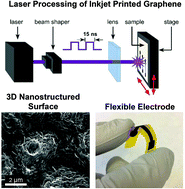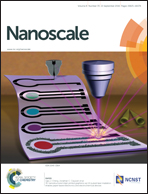3D nanostructured inkjet printed graphene via UV-pulsed laser irradiation enables paper-based electronics and electrochemical devices†
Abstract
Emerging research on printed and flexible graphene-based electronics is beginning to show tremendous promise for a wide variety of fields including wearable sensors and thin film transistors. However, post-print annealing/reduction processes that are necessary to increase the electrical conductivity of the printed graphene degrade sensitive substrates (e.g., paper) and are whole substrate processes that are unable to selectively anneal/reduce only the printed graphene—leaving sensitive device components exposed to damaging heat or chemicals. Herein a pulsed laser process is introduced that can selectively irradiate inkjet printed reduced graphene oxide (RGO) and subsequently improve the electrical conductivity (Rsheet ∼0.7 kΩ □−1) of printed graphene above previously published reports. Furthermore, the laser process is capable of developing 3D petal-like graphene nanostructures from 2D planar printed graphene. These visible morphological changes display favorable electrochemical sensing characteristics—ferricyanide cyclic voltammetry with a redox peak separation (ΔEp) ≈ 0.7 V as well as hydrogen peroxide (H2O2) amperometry with a sensitivity of 3.32 μA mM−1 and a response time of <5 s. Thus this work paves the way for not only paper-based electronics with graphene circuits, it enables the creation of low-cost and disposable graphene-based electrochemical electrodes for myriad applications including sensors, biosensors, fuel cells, and theranostic devices.



 Please wait while we load your content...
Please wait while we load your content...